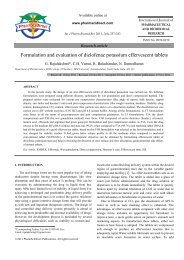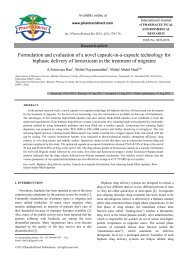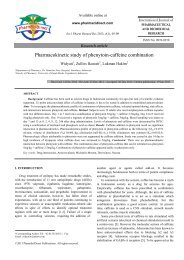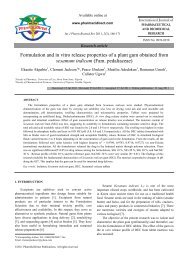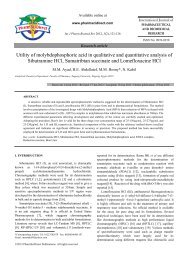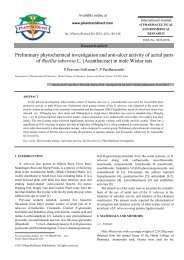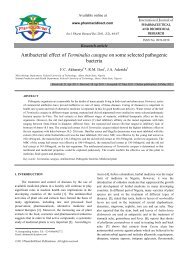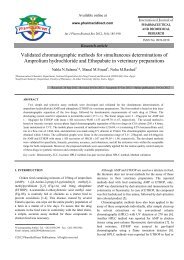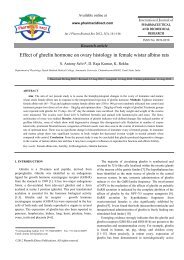Conjoined twins: A rare case report - PharmSciDirect
Conjoined twins: A rare case report - PharmSciDirect
Conjoined twins: A rare case report - PharmSciDirect
- No tags were found...
You also want an ePaper? Increase the reach of your titles
YUMPU automatically turns print PDFs into web optimized ePapers that Google loves.
Available online atwww.pharmscidirect.comInt J Pharm Biomed Res 2013, 4(3), 187-188Case <strong>report</strong>International Journalof PHARMACEUTICALAND BIOMEDICALRESEARCHISSN No: 0976-0350<strong>Conjoined</strong> <strong>twins</strong>: A <strong>rare</strong> <strong>case</strong> <strong>report</strong>N.Deepika 1 *, Arun Kumar 21 Department of Obstetrics and Gynaecology, Sri Devaraj Urs Medical college, Tamaka, Kolar-563 101, Karnataka, India2 Department of Obstetrics and Gynaecology, Indira Gandhi Medical College, Shimla-171 001, Himachal Pradesh, IndiaReceived: 15 Aug 2013 / Revised: 23 Aug 2013 / Accepted: 25 Aug 2013 / Online publication: 02 Sep 2013ABSTRACT<strong>Conjoined</strong> twin is a <strong>rare</strong> occurance in obstetric practice. In the present <strong>case</strong> study, we are <strong>report</strong>ing one <strong>case</strong> ofcranithoracophagus conjoined <strong>twins</strong>. A 30 year old women unbooked gravida 3 para 2 living 2 <strong>report</strong>ed to antenatal OPD forroutine antentatal check up. Obstetric scan was done which revealed twin pregnancy, monochorionic monoamnioticconjoined twin of 26 weeks 5 days. The separation of conjoined <strong>twins</strong> is associated with increased chance of perinatalmortality. Therefore, making an early diagnosis with ultrasonographic examination provides the parents a chance to opt forpregnancy termination.Key words: <strong>Conjoined</strong> <strong>twins</strong>, Craniothoracophagus1. INTRODUCTIONTwins is not an uncommon phenomenon but conjoined<strong>twins</strong> are indeed a rarity, since the event occurs only once in50,000–60,000 births [1]. If twinning is initiated after theembryonic disc and amniotic sac have formed and if thedivision of the embryonic disc is incomplete, conjoined <strong>twins</strong>result [2]. Approximately 40-60% of conjoined <strong>twins</strong> arrivestillborn, and about 35% survive only one day. The overallsurvival rate of conjoined <strong>twins</strong> is somewhere between 5 and25%.We <strong>report</strong> a <strong>rare</strong> <strong>case</strong> of conjoined <strong>twins</strong> who presentedrecently in our department.2. CASE REPORTA 30 year old women unbooked gravida 3 para 2 living 2<strong>report</strong>ed to antenatal OPD for routine antentatal check up.Her LMP was 26.08.2011 and her period of gestation was 28weeks 3 days.*Corresponding Author. Tel: +91 9916054700Email: deepikang@gmail.comFax:©2013 <strong>PharmSciDirect</strong> Publications. All rights reserved.Obstetric history:First child was FTND of female baby at a governmenthospital, baby 5 years old, alive and healthy. Secondpregnancy was FTND of female baby at government hospital,baby 2 years old, alive and healthy. There was no history oftwinning in the family. On her examination, she was averagebuilt and nourished. Her general physical and systemicexamination was normal. Obstetrical examination: fundalheight was 32 weeks, fetal parts were palpable and exactpresentation could not be made out.Investigations:Hb 10.8g%, blood group O+ve, urine examination wasnormal. Obstetric scan was done which revealed twinpregnancy, monochorionic monoamniotic conjoined twin of26 weeks 5 days. Presentation was cephalic, placenta fundal,AFI of 16-17cm, fetal heart of both <strong>twins</strong> present and therewas fusion of head, chest and abdomen of both fetuses. Thepatient and her relatives were counselled about theincompatibility of life and after arranging blood she wasinduced with 50µg of misoprostol, 2 doses 6 hours apart. Shehad vaginal delivery of twin female babies which were stillborn and weighed 2.4kg (Fig.1). The baby had four arms,four legs, one head and chest and abdomen was fused (Fig.2).The placenta was single and weighed 650g. Third stage wasuneventful.
N.Deepika and Arun Kumar, Int J Pharm Biomed Res 2013, 4(3), 187-188 188Fig 1: Cranithoracophagus conjoined <strong>twins</strong>approximately 13-15 days postovulation. Most conjoined<strong>twins</strong> are female, with the ratio of women to men being<strong>report</strong>ed as 2:1 or 3:1. Many of these infants are deliveredprematurely and are stillborn. They are classified accordingto their site of union. The most common location is the chest(thoracopagus), followed by the anterior abdominal wall fromthe xiphoid to the umbilicus (xiphopagus), the buttocks(pygopagus), the ischium (ischiopagus), and the head(craniopagus) [3]. Organs may be shared to varying degreesin different sets of <strong>twins</strong>. Major congenital anomalies of oneor both <strong>twins</strong> are not uncommon. Polyhydramnios is said tobe present in almost one half of the <strong>report</strong>ed <strong>case</strong>s ofconjoined <strong>twins</strong>. Antenatal diagnosis by ultrasound ispossible in modern day obstetrics. Ultrasonographicidentification of any of the following classical signs maysuggest the diagnosis: both fetal heads in the same plane,unusual backward flexion of the cervical spine, no change inthe relative position after maternal movement and manualmanipulations and inability to separate fetal bodies aftercareful observation [4].Caesarean delivery near term is the preferred method ofdelivery to minimize maternal and fetal injury. If the <strong>twins</strong>are thought to have a poor chance of surviving and are smallenough to pass through the birth canal without damaging themother, vaginal delivery might be considered.Separation of conjoined <strong>twins</strong> is complicated procedure.The importance of multidiscipline team with rehearsal of allaspects (surgical, anaesthetic and nursing) of the operativeprocedure cannot be overemphasized. Although the outcomeis influenced by careful planning and organization from allparticipants, the prognosis is often predetermined by theunderlying anatomy which may preclude successfulseparation [5].4. CONCLUSIONFig 2: X-ray of the conjoined <strong>twins</strong>The separation of conjoined <strong>twins</strong> is associated withincreased chance of perinatal mortality. Therefore, making anearly diagnosis with ultrasonographic examination providesthe parents a chance to opt for pregnancy termination.REFERENCES3. DISCUSSION<strong>Conjoined</strong> <strong>twins</strong> occur with a frequency of about 1 per50,000 deliveries and are an extremely <strong>rare</strong> complication ofmonochorionic twinning. The precise etiology of conjoinedtwinning is unknown, but the most widely accepted theory isthat incomplete division of a monozygotic embryo occurs at[1] Tan, K.L., Goon, S.M., Salmon, Y., Wee, J.H., Acta Obstet GynecolScand 1971, 50, 373-380.[2] Cunningham, F.G., MacDonald, P.C., Gant, N.F., Williams Obstetrics,21 st Edn. McGraw-Hill, New York 2003.[3] Malone, F.D., D’Alton, M.E., Clin Perinatol 2000, 27, 1033-1046.[4] Kalchbrenner, M., Weiner, S., Templeton, J., Losure, T.A., J ClinUltrasound 1987, 15, 59-63.[5] Miller, D., Colobani, P., Buck, J.R., Dudgeon, D.L., Haller, J.A., J PedSurg 1983, 18, 373-376.



